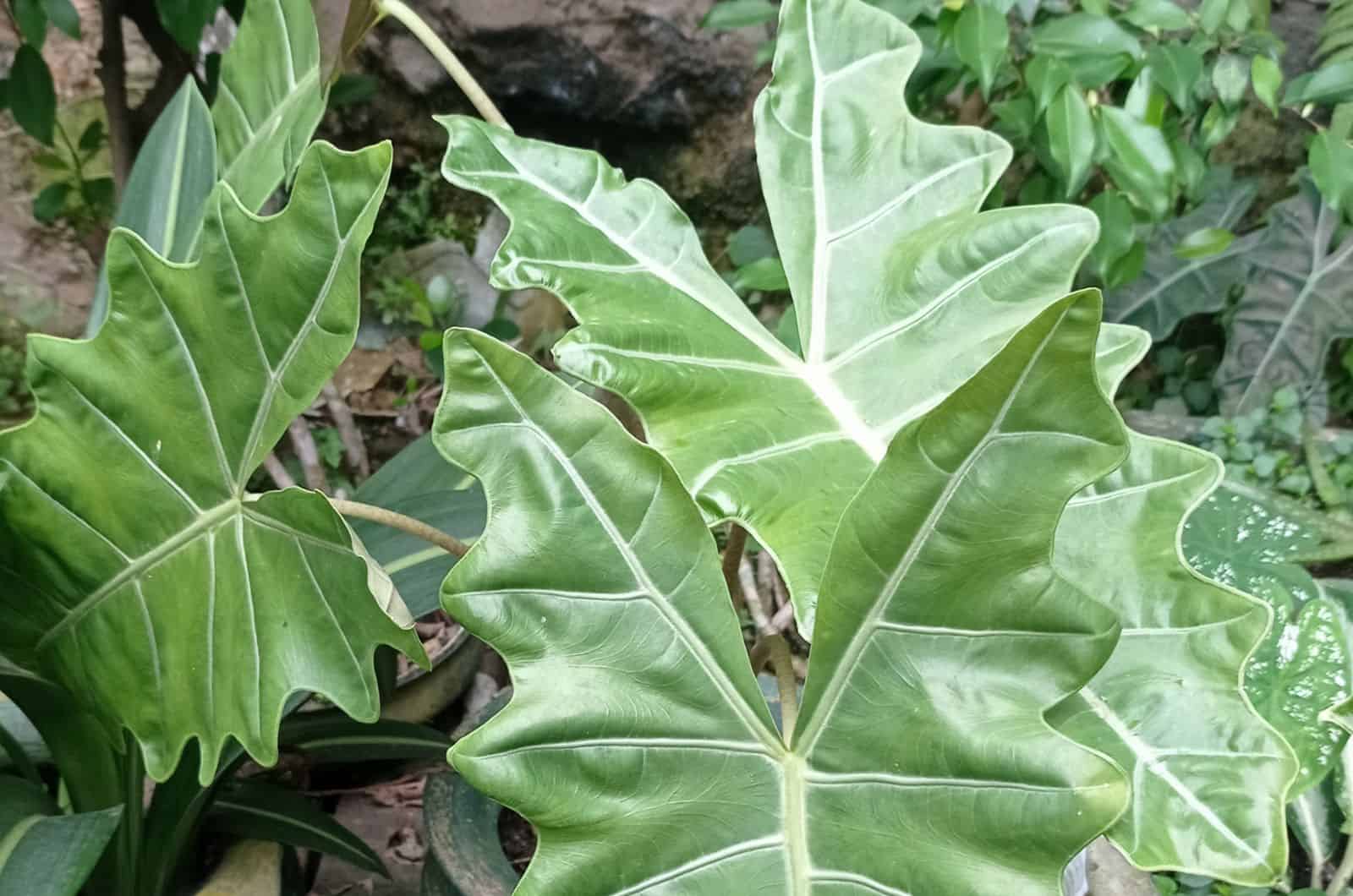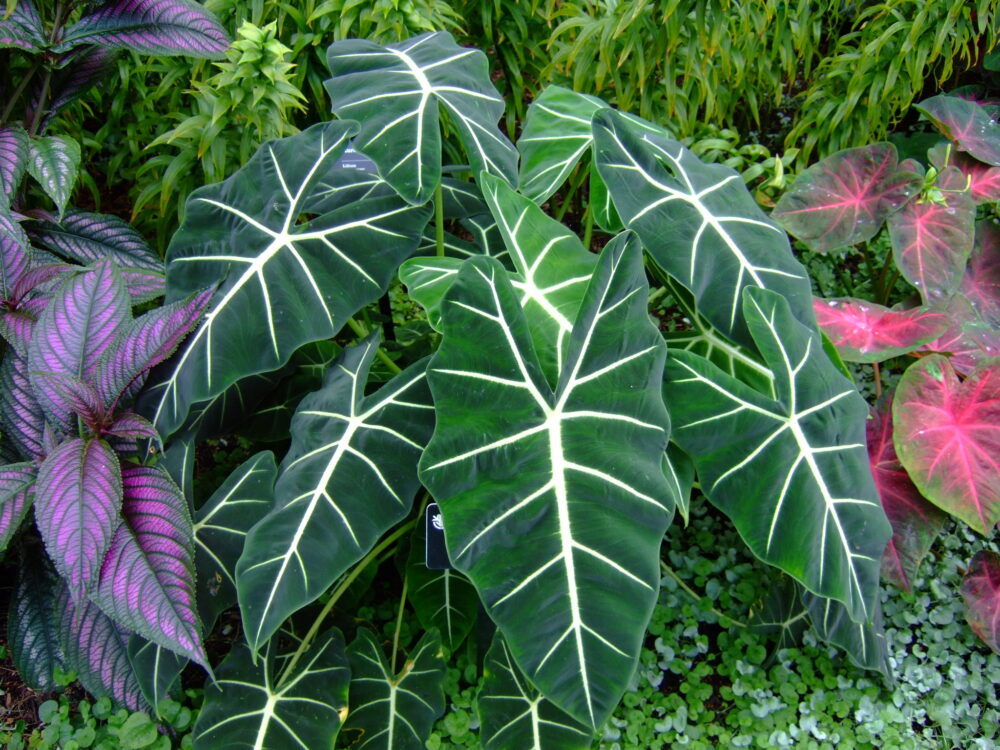What to Expect from Alocasia Growth
Alocasia plants, also known as African Mask plants or Elephant Ear plants, are popular for their distinctive, large, arrowhead-shaped leaves and ornamental value. These striking plants are often grown indoors as houseplants, but some species can also thrive outdoors in warmer climates. A common question among gardeners and plant enthusiasts is, “How big do Alocasia get?”. This article aims to provide an overview of the growth expectations for various Alocasia species.
Factors Influencing Alocasia Size
Alocasia plants can vary significantly in size, depending on several factors. The species of Alocasia is one of the primary determinants of the plant’s mature size. Some Alocasia species, like Alocasia macrorrhizos (Giant Taro) or Alocasia robusta (Robust Alocasia), can reach impressive heights and spreads, while other species, such as Alocasia x amazonica ‘Polly’ or Alocasia ‘Regal Shields’, tend to remain more compact.
Proper care is another crucial factor that impacts the size of Alocasia plants. Providing the right conditions for growth, such as adequate watering, lighting, soil, and fertilization, can significantly influence the overall size and health of the plant. For instance, underwatering or overwatering can stunt Alocasia growth, while insufficient light can limit the plant’s size potential.
Environmental factors, such as temperature, humidity, and available space, also play a role in Alocasia size. Warmer temperatures and higher humidity levels generally promote faster and larger growth, while cooler conditions can slow down growth and restrict the plant’s size. Lastly, the age of the Alocasia plant is a significant factor in its size. As Alocasia plants mature, they typically grow larger, with more extensive leaf structures and denser foliage.
Popular Alocasia Species and Their Size
A few common Alocasia species and their average sizes are outlined below. These examples and images can help readers visualize the mature sizes of these plants.
Alocasia macrorrhizos (Giant Taro)

Alocasia macrorrhizos, also known as Giant Taro, is one of the largest Alocasia species. It can reach heights of up to 15 feet (4.5 meters) and have a spread of 10 feet (3 meters) or more. This species is characterized by its massive, green, arrowhead-shaped leaves and thick, starchy rhizomes.
Alocasia amazonica ‘Polly’

Alocasia amazonica ‘Polly’ is a popular compact Alocasia variety, typically growing to a height of 2-3 feet (0.6-0.9 meters) and a spread of 1-2 feet (0.3-0.6 meters). It features dark green, textured leaves with contrasting, bright white veins, making it an attractive choice for indoor spaces.
Alocasia ‘Regal Shields’

Alocasia ‘Regal Shields’ is another smaller Alocasia species, reaching a height of 2-3 feet (0.6-0.9 meters) and a spread of 1-2 feet (0.3-0.6 meters). It is known for its large, glossy, deep green leaves with prominent, silver veins, giving it a striking appearance.
Growth Stages of Alocasia Plants
Alocasia plants progress through several growth stages, from seedling to mature plant. Understanding these stages can help gardeners and plant enthusiasts better care for their Alocasia and appreciate the plant’s development.
Seedling Stage
The seedling stage begins when the Alocasia plant emerges from the seed. At this stage, the plant is delicate and requires gentle care. The first leaves, called cotyledons, are usually rounded and not representative of the mature plant’s leaf shape. As the seedling grows, it develops its first true leaves, which resemble the adult leaves but are typically smaller.
Juvenile Stage
During the juvenile stage, Alocasia plants grow rapidly, and their leaves become larger and more similar to the mature plant’s leaves. The plant may develop multiple stems, and the rhizome or tuber starts to expand, indicating a more robust root system. This stage is an excellent time to repot the Alocasia if it becomes root-bound.
Mature Stage
The mature stage is characterized by a stable, well-established root system and consistent growth. Mature Alocasia plants produce larger leaves and may start to flower, depending on the species. At this stage, the plant has reached its full potential size, given the right care and environmental conditions.
Senescence Stage
As Alocasia plants age, they enter the senescence stage, where growth slows down, and the plant may start to decline. This stage is a natural part of the plant’s life cycle, and it’s essential to provide proper care to maintain the plant’s health and appearance for as long as possible.
How to Promote Healthy Alocasia Growth
To ensure optimal growth and achieve the desired size for your Alocasia plant, follow these tips and best practices for proper watering, lighting, soil, and fertilization.
Watering
Alocasia plants prefer consistently moist but well-drained soil. Overwatering or underwatering can negatively impact their growth. To maintain the right moisture levels, water your Alocasia when the top inch (2.5 cm) of soil becomes slightly dry. Be sure to empty any excess water from saucers or trays to prevent root rot.
Lighting
Alocasia plants generally thrive in bright, indirect light. Too much direct sunlight can scorch their leaves, while insufficient light can lead to weak growth and smaller leaves. Place your Alocasia near an east- or north-facing window if growing indoors, or ensure it receives dappled sunlight outdoors.
Soil
Choose a well-draining, rich, and slightly acidic soil mix for your Alocasia. A high-quality houseplant potting soil with added perlite or vermiculite for improved drainage is usually a suitable choice. Avoid heavy soils that retain too much moisture, as they can lead to root rot and other issues.
Fertilization
Fertilize your Alocasia regularly during the growing season (spring and summer) with a balanced, water-soluble houseplant fertilizer. Dilute the fertilizer to half the recommended strength to prevent over-fertilization, which can lead to stunted growth and other problems. Reduce fertilization during the dormant season (fall and winter) to give the plant a rest.
By following these guidelines, you can promote healthy Alocasia growth, contributing to the overall size and vitality of the plant. Remember that each Alocasia species may have specific care requirements, so research your specific plant to ensure the best possible care.
Maintaining and Controlling Alocasia Size
Alocasia plants can grow quite large, so it’s essential to manage their size to prevent them from becoming too large for their environment. Proper pruning, repotting, and care can help maintain the desired size and shape of your Alocasia.
Pruning
Pruning is an essential technique for controlling the size of your Alocasia. Regularly remove yellow or brown leaves to encourage new growth and maintain a tidy appearance. Use clean, sharp pruning shears or scissors to make clean cuts, reducing the risk of infection. Pruning also helps promote bushier growth and can improve the overall health of the plant.
Repotting
Repotting is another crucial aspect of maintaining Alocasia size. When the plant becomes root-bound, it may become pot-bound, leading to stunted growth and other issues. Generally, Alocasia plants should be repotted every 2-3 years or when they outgrow their current pot. Choose a new pot that is 1-2 inches (2.5-5 cm) larger in diameter than the current one, and ensure it has proper drainage holes.
Proper Care
Proper care plays a significant role in managing Alocasia size. Ensure your plant receives the right amount of water, light, and nutrients to promote healthy growth. Overfeeding or underfeeding, overwatering or underwatering, and insufficient or excessive light can all contribute to uncontrolled growth or stunted growth. Regularly monitor your Alocasia for signs of problems and adjust its care accordingly.
By employing these techniques, you can maintain and control the size of your Alocasia, ensuring it remains a healthy and attractive addition to your indoor or outdoor space. Remember that each Alocasia species may have specific care requirements, so research your specific plant to provide the best possible care.
Addressing Common Alocasia Growth Issues
Alocasia plants, like any other living organism, can face various challenges that may hinder their growth and development. Common issues affecting Alocasia growth include pests, diseases, and nutrient deficiencies. Identifying these problems early on and addressing them promptly can help ensure your plants reach their full growth potential.
Pests
Common pests affecting Alocasia plants are spider mites, aphids, mealybugs, and scale insects. These pests can cause damage by sucking the sap from leaves and stems, leading to weakened plants and stunted growth. To combat pests, use insecticidal soap, neem oil, or other eco-friendly pesticides. Regularly inspect your plants for signs of infestation and isolate affected plants to prevent the spread of pests.
Diseases
Diseases such as root rot, powdery mildew, and leaf spot can affect Alocasia plants. These diseases are often caused by poor watering practices, high humidity, or poor air circulation. To prevent diseases, ensure your Alocasia plants have proper drainage, water them correctly, and maintain good air circulation. If a plant becomes infected, remove affected parts or the entire plant, if necessary, to prevent the spread of the disease.
Nutrient Deficiencies
Nutrient deficiencies can also impact Alocasia growth. Common deficiencies include nitrogen, phosphorus, and potassium. Symptoms of nutrient deficiencies include yellowing leaves, stunted growth, and weak stems. To address nutrient deficiencies, use a balanced, water-soluble houseplant fertilizer and follow the manufacturer’s instructions for dilution and application. Regularly test your soil to ensure it contains the proper nutrient levels for your Alocasia plants.
By being vigilant and addressing these common issues, you can help your Alocasia plants reach their full growth potential and maintain their health and vitality. Remember that each Alocasia species may have specific care requirements, so research your specific plant to provide the best possible care.
Enjoying Your Full-Grown Alocasia
Alocasia plants, when provided with the right care and attention, can grow into magnificent specimens, adding a touch of exotic beauty to any indoor or outdoor space. Nurturing an Alocasia from a small seedling to a full-grown, thriving plant can be a rewarding and satisfying experience for gardeners and plant enthusiasts alike.
Full-grown Alocasia plants display their unique characteristics in all their glory, from their distinctive, arrowhead-shaped leaves to their eye-catching patterns and vibrant colors. These plants become stunning focal points, bringing a sense of the tropics into your home or garden. The size and maturity of an Alocasia plant not only contribute to its visual appeal but also indicate its overall health and vitality.
To fully enjoy your full-grown Alocasia, ensure it remains in optimal condition by providing proper watering, lighting, and nutrients. Regularly inspect the plant for signs of pests or diseases, and address any issues promptly. Rotate your Alocasia periodically to ensure even light exposure, promoting balanced growth and an aesthetically pleasing appearance.
Alocasia plants can live for many years when given the right care, making them a long-term investment in your indoor or outdoor landscape. By understanding the growth expectations, factors influencing size, and common challenges associated with Alocasia plants, you can help your plants reach their full growth potential and enjoy the many benefits they bring to your space.








/GettyImages-10174297-5c3097e146e0fb000148b454.jpg)
